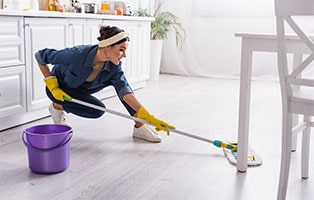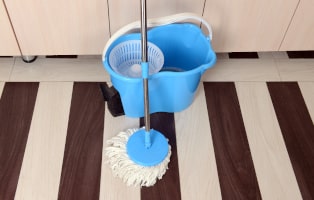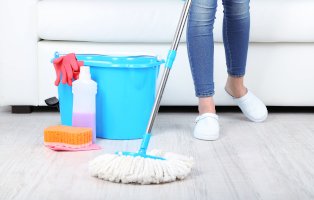Dive into our information-packed article if you want to know how to clean walls and wallpaper like a pro!
It sometimes seems like horizontal surfaces get all the love and attention in the average home. For example, virtually everyone on the planet mops their floors and vacuums their rugs.
However, few people regularly clean their walls. This isn’t good, considering how much bacteria, dirt, and grime can accumulate on them over time. This not only makes a room look dingy, but the allergens they attract can worsen respiratory illnesses. If you want your home to look radiant and therefore inviting, consider making wiping down walls part of your household cleaning routine.
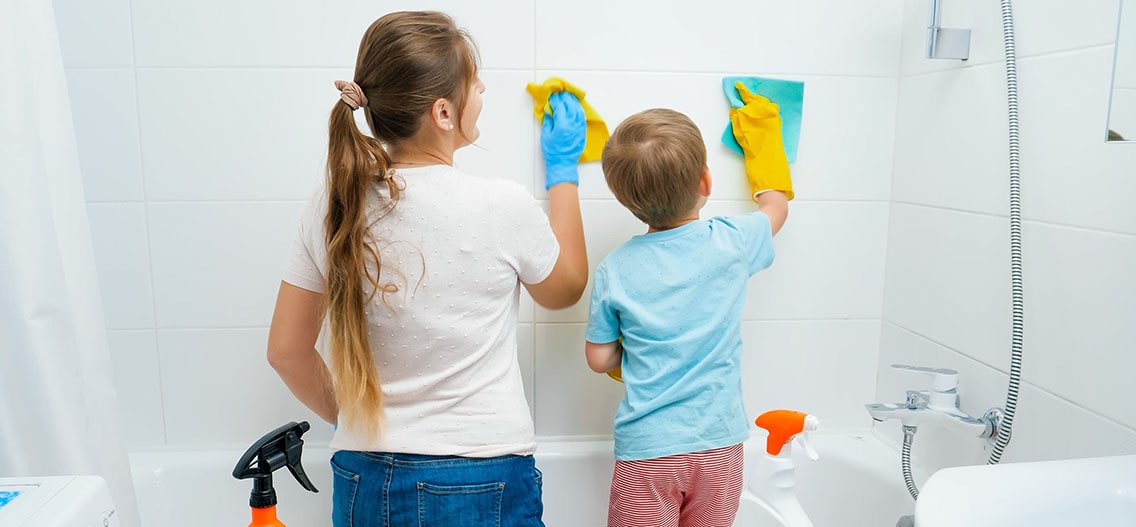
It’s best to wash walls on a warm, dry day. That way, you can open the windows afterward, which will help them to dry out.
The 8 Steps to Cleaning Your Walls
Step One: Always Be Safe
Keep electrical safety in mind when washing walls. Don’t get areas such as light switches, thermostats, and electrical outlets wet. Turn off breakers before cleaning dirty switch plates.
Step Two: Gather Your Supplies
You might be surprised to hear cleaning walls doesn’t require any equipment or chemicals. In fact, you probably already have everything you need to do a bang-up job on your dingy walls. Here’s the list of essential wall-cleaning supplies:
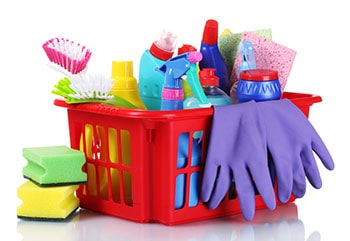
- Dish soap
- Soft cloths
- Microfiber cloth
- Two buckets
- Vacuum with a dust brush attachment
- Baking soda
- Foam craft brush
Step Three: Protect Your Furniture
There’s no avoiding drips from cleaning solution and dust and dirt falling when you clean your walls. To prevent furniture and flooring from getting ruined, lay towels along the base of the walls and put plastic sheeting over the furnishings.
Step Four: Dust
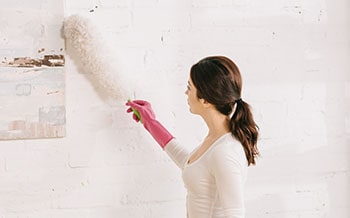
Unfortunately, dust has an uncanny ability to settle on every square inch of household surfaces, including walls. You’ll need to clear it all away before doing your deep cleaning. If you don’t, you’ll end up with a muddy mess when you try to spray liquid cleaner on your vertical surfaces.
Use your vacuum cleaner’s brush attachment to remove dust. Begin from the top and move downwards. Go over it with a microfiber cloth a second time to ensure you get rid of all dust particles.
If you need to remove dust from baseboards and molding, use a foam craft brush. You can also wrap a dry mop head with a clean rag. Use an ordinary broom covered with a microfiber dusting cloth if you need to dust drywall.
Step Five: Set Up Your Two Buckets
Once you wipe all the dust away, you’re ready to wash the walls. Fill one bucket with a gallon of warm water. This is your rinse bucket. Then, mix your preferred cleaning solution with water in the other bucket.
Step Six: Spot Test
Always test an inconspicuous area (such as behind a painting or furniture) to ensure that your cleaning solution won’t damage the surface.
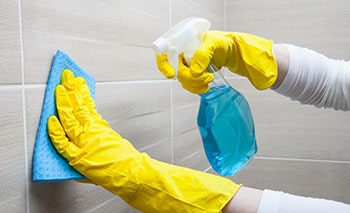
Step Seven: Wash
Use a natural sponge to prevent dyes from transferring to the wall surfaces. Do one three feet by three feet section at a time.
Wash the wall from top to bottom and from left to right. Pay particular attention to areas that get touched frequently by human hands. For example, around light switches and doorknobs. Rinse with a second sponge and clear water.
Step Eight: Dry
Lastly, you’ll need to dry the walls by running a clean, dry cloth over them or keeping your windows open to air dry them.
How To Clean Various Types of Walls
Painted Walls
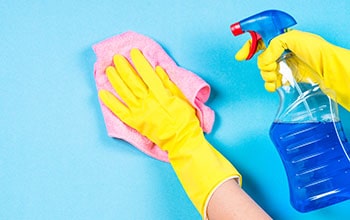
You don’t need to add a coat of fresh paint if your painted walls are starting to look dull and dingy. Instead, try cleaning them thoroughly. Giving your walls an annual deep cleaning can go a long way towards making a room look bright, cheerful, and inviting. To clean walls with a flat finish, mix ¼ cup liquid dishwashing detergent with one-gallon warm water.
The best way to clean latex finishes is by using warm water, dish soap, or distilled white vinegar as your cleanser. If you want to clean walls with oil-based paint, use a mixture of warm water, dish soap, and baking soda. The dish soap cuts through the dirt, while the baking soda is a mild abrasive that’ll help scrub away tougher stains.
Wood Walls
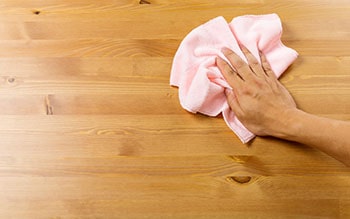
To clean wood walls, mix one cup of water, ¼ cup white vinegar, ½ cup mineral oil, and 15 drops of lemon oil. After thoroughly mixing your ingredients, use a clean cloth to work the cleaner in the wood. Always go with the grain as you do so.
Use a little more pressure on stubborn stains. You won’t have to rinse; just let the area air dry. This should leave your wood surfaces with not only a radiant shine but a pleasant lemon aroma. For spot cleaning, use a cloth dampened with lemon oil.
Brick and Concrete
One cup of dish soap and one cup of salt works best for these surfaces. The dish soap cuts through grease and grime, while the salt acts as an abrasive to remove stains.
Wallpaper
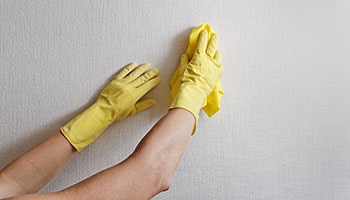
Because wallpaper can be easily ruined, it needs to be delicately cleaned. This is particularly true with older, non-coated wallpaper. In cases like this, damage is hard to repair without entirely replacing the wallpaper. To ensure you inadvertently don’t cause damage, steer clear of scouring cleansers or abrasive cloth.
To clean your wallpaper, start by dusting it with a broom wrapped in a microfiber cloth. Then, use a sponge soaked in soapy water to clean the dirt. Make sure that the wallpaper doesn’t get too wet. Wipe with a microfiber cloth to absorb excess moisture.
If you need to clean up fingerprints and smudges, spot clean them with an artist’s gum eraser. If you have older, more delicate wallpaper, use a dry sponge. This eradicates dirt without adding potentially damaging moisture.
How to Clean Stains on Painted Walls
If you have a wall stain you need to eradicate on a painted wall., you’re going to need to act quickly. That’s because the sooner you get to it, the better chance you have of getting rid of it. To treat this kind of stain, mix a few tablespoons of baking soda with warm water until you form a paste.
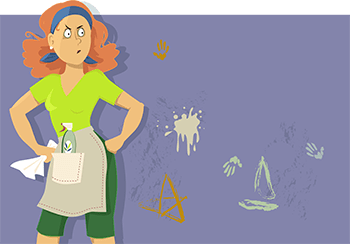
Work the mixture into the stain. The stain should lift right out. If any residue remains, wipe it away with a damp cloth.
If this method doesn’t work, stir one teaspoon of liquid dish detergent into a quart of warm water. Then, add ¼ teaspoon of white vinegar. Let the solution soak up the stain for 10 minutes before blotting. To prevent color from transferring from your towel to your walls, use a white lint-free rag or a microfiber cloth.
If the above methods don’t remove the stain, you might have to conceal it with a bit of touch-up paint. If feasible, use paint from the original can used to paint the walls. Also, try to use the same application method, whether that’s a roller or a brush.
If there are grease stains on your walls, place a paper towel on top of the grease stain. Then, press an iron that’s set on low heat on top of the paper towels for one minute. The paper towels should absorb the grease.
Keep Walls Clean with Regular Maintenance
If you want your walls to always have that “freshly painted” look, regularly spot clean them. This means doing things like wiping away fingerprints and other blemishes like sticker residue as soon as you see them. Focus most of your attention on high traffic areas and problem spots such as doorknobs and light switches. Choosing durable wall treatments is another way to cut down on your cleaning time.
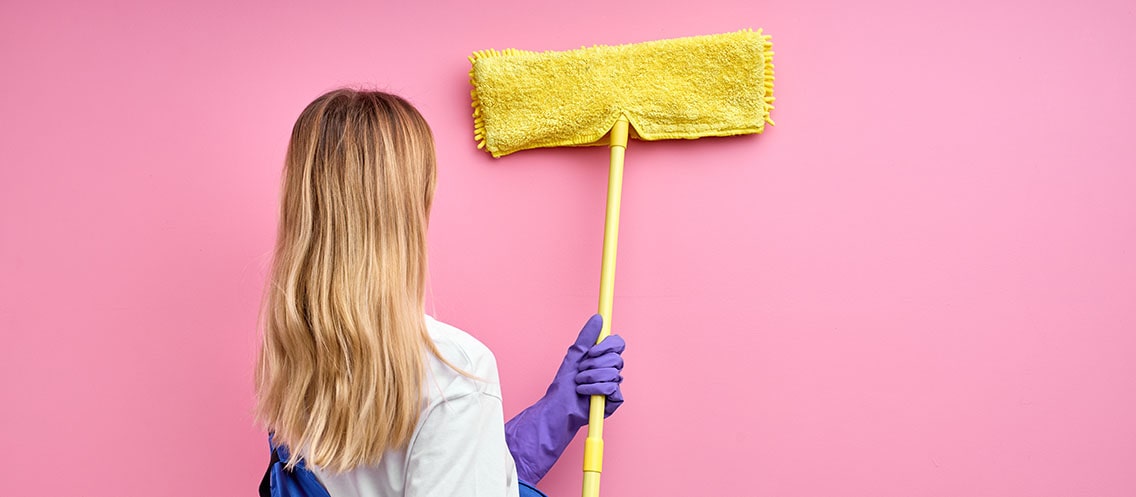
Some pros use a decidedly unconventional tool to wash walls: a mop. If you want to try this, use a flat mop instead of a traditional string mop because a flat mop covers a broader area.
Final Thoughts
Washing walls isn’t exactly the most enjoyable household task. However, it must be done. If you adhere to the tips in this article, you’ll find that you get better results faster.
Which technique did you find most helpful? Let us know in the comments!

Mop Tips & Tricks
